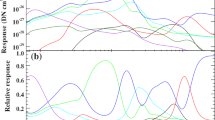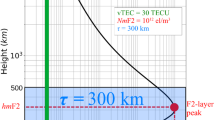Abstract
We develope a method to compute the temperature and density structure along the line of sight by inversion of the differential emission measure (DEM), under the assumptions of stratification and hydrostatic equilibrium. We apply this method to the DEM obtained from the Atmospheric Imaging Assembly (AIA) observations and use the results, together with potential extrapolations of the photospheric magnetic field, to compute the microwave emission of three sunspots, which we compare with observations from the Academy of Sciences Radio Telescope - 600 (RATAN-600) radio telescope and the Nobeyama Radioheliograph (NoRH). Our DEM-based models reproduce very well the observations of the moderate-size spot on October 2011 and within 25% the data of a similar sized spot on March 2016, but predict too low values for the big spot of 14 April 2016. The latter is better fitted by a constant conductive flux atmospheric model which, however, cannot reproduce the peak brightness temperature of \(4.7\times 10^{6}~\mbox{K}\) and the shape of the source at the NoRH frequency. We propose that these deviations are due to the low intensity non-thermal emission associated to a moving pore and to an opposite polarity light bridge. We also find that the double structure of the big spot at high RATAN-600 frequencies can be interpreted in terms of the variation of the angle between the magnetic field and the line of sight along the sunspot.
















Similar content being viewed by others
References
Akhmedov, S.B., Borovik, V.N., Gelfreikh, G.B., Bogod, V.M., Korzhavin, A.N., Petrov, Z.E., Dikij, V.N., Lang, K.R., Willson, R.F.: 1986, Astrophys. J. 301, 460. DOI .
Alissandrakis, C.E., Kundu, M.R., Lantos, P.: 1980, Astron. Astrophys. 82, 30.
Alissandrakis, C.E.: 1981, Astron. Astrophys. 100, 197.
Alissandrakis, C.E., Kundu, M.R.: 1982, Astrophys. J. 253, L49. DOI .
Alissandrakis, C.E., Kundu, M.R.: 1984, Astron. Astrophys. 139, 271.
Alissandrakis, C.E., Gel’Frejkh, G.B., Borovik, V.N., Korzhavin, A.N., Bogod, V.M., Nindos, A., Kundu, M.R.: 1993, Astron. Astrophys. 270, 509.
Alissandrakis, C.E., Kochanov, A.A., Patsourakos, S., Altyntsev, A.T., Lesovoi, S.V., Lesovoya, N.N.: 2013, Publ. Astron. Soc. Japan 65, S8. DOI .
Avrett, E.H., Loeser, R.: 2008, Astrophys. J. Suppl. 175, 229. DOI .
Avrett, E., Tian, H., Landi, E., Curdt, W., Wülser, J.-P.: 2015, Astrophys. J. 811, 87. DOI .
Bakunina, I.A., Melnikov, V.F., Solov’ev, A.A., Abramov-Maximov, V.E.: 2015, Solar Phys. 290, 37. DOI .
Bezrukov, D., Ryabov, B., Peterova, N., Topchilo, N.: 2011, Latv. J. Phys. Tech. Sci. 48, 56. DOI .
Bogod, V.M.: 2011, Astrophys. Bull. 66, 190. DOI .
Bogod, V.M., Alesin, A.M., Pervakov, A.A.: 2011, Astrophys. Bull. 66, 205. DOI .
Bogod, V.M., Kaltman, T.I., Yasnov, L.V.: 2012, Astrophys. Bull. 67, 425. DOI .
Bogod, V.M., Peterova, N.G., Ryabov, B.I., Topchilo, N.A.: 2015, Cosm. Res. 53, 10. DOI .
Chiuderi Drago, F., Alissandrakis, C., Hagyard, M.: 1987, Solar Phys. 112, 89. DOI .
Chiuderi Drago, F., Melozzi, M.: 1984, Astron. Astrophys. 131, 103.
Gelfreikh, G.B., Lubyshev, B.I.: 1979, Astron. Zh. 56, 562.
Gelfreikh, G.B.: 1990 In: Basic Plasma Processes on the Sun, IAU Symp. 142, Kluwer Academic, Dordrecht, 483.
Hannah, I.G., Kontar, E.P.: 2012, Astron. Astrophys. 539, A146. DOI .
Harper, G.M.: 1992, Mon. Not. Roy. Astron. Soc. Lett. 256, 37. DOI .
Kakinuma, T., Swarup, G.: 1962, Astrophys. J. 136, 975. DOI .
Kaltman, T.I., Bogod, V.M., Stupishin, A.G., Yasnov, L.V.: 2012, Astron. Rep. 56, 790. DOI .
Kaltman, T.I., Bogod, V.M., Stupishin, A.G., Yasnov, L.V.: 2013, Geomagn. Aeron. 53, 1030. DOI .
Kaltman, T.I., Kochanov, A.A., Myshyakov, I.I., Maksimov, V.P., Prosovetsky, D.V., Tokhchukova, S.K.: 2015, Geomagn. Aeron. 55, 1124. DOI .
Korzhavin, A.N., Opeikina, L.V., Peterova, N.G.: 2010, Astrophys. Bull. 65, 60. DOI .
Krüger, A., Hildebrandt, J., Fürstenberg, F.: 1985, Astron. Astrophys. 143, 72.
Kundu, M.R., Alissandrakis, C.E., Bregman, J.D., Hin, A.C.: 1977, Astrophys. J. 213, 278. DOI .
Landi, E., Chiuderi Drago, F.: 2008, Astrophys. J. 675, 1629. DOI .
Lang, K.R., Willson, R.F., Kile, J.N., Lemen, J., Strong, K.T., Bogod, V.L., Gelfreikh, G.B., Ryabov, B.I., Hafizov, S.R., Abramov, V.E., Svetkov, S.V.: 1993, Astrophys. J. 419, 398. DOI .
Levine, R.H., Withbroe, G.L.: 1977, Solar Phys. 51, 83. DOI .
Nindos, A., Alissandrakis, C.E., Gelfreikh, G.B., Kundu, M.R., Dere, K.P., Korzhavin, A.N., Bogod, V.M.: 1996, Solar Phys. 166, 55. DOI .
Nindos, A., Kundu, M.R., White, S.M., Shibasaki, K., Gopalswamy, N.: 2000, Astrophys. J. Suppl. 130, 485. DOI .
Nita, G.M., Viall, N.M., Klimchuk, J.A., Loukitcheva, M.A., Gary, D.E., Kuznetsov, A.A., Fleishman, G.D.: 2018, Astrophys. J. 853, 66. DOI .
Plowman, J., Kankelborg, C., Martens, P.: 2013, Astrophys. J. 771, 2. DOI .
Rosner, R., Tucker, W.H., Vaiana, G.S.: 1978, Astrophys. J. 220, 643. DOI .
Ryabov, B.I., Gary, D.E., Peterova, N.G., Shibasaki, K., Topchilo, N.A.: 2015, Solar Phys. 290, 21. DOI .
Selhorst, C.L., Silva-Válio, A., Costa, J.E.R.: 2008, Astron. Astrophys. 488, 1079. DOI .
Strong, K.T., Alissandrakis, C.E., Kundu, M.R.: 1984, Astrophys. J. 277, 865. DOI .
Stupishin, A.G., Kaltman, T.I., Bogod, V.M., Yasnov, L.V.: 2018, Solar Phys. 293, 13. DOI .
Syntelis, P., Gontikakis, C., Patsourakos, S., Tsinganos, K.: 2016, Astron. Astrophys. 588, A16. DOI .
Tian, H., Curdt, W., Teriaca, L., Landi, E., Marsch, E.: 2009, Astron. Astrophys. 505, 307. DOI .
Topchilo, N.A., Peterova, N.G., Borisevich, T.P.: 2010, Astron. Rep. 54, 69. DOI .
Tun, S.D., Gary, D.E., Georgoulis, M.K.: 2011, Astrophys. J. 728, 1. DOI .
Uralov, A.M., Rudenko, G.V., Rudenko, I.G.: 2006, Publ. Astron. Soc. Japan 58, 21. DOI .
Uralov, A.M., Grechnev, V.V., Rudenko, G.V., Rudenko, I.G., Nakajima, H.: 2008, Solar Phys. 249, 315. DOI .
Wang, Z., Gary, D.E., Fleishman, G.D., White, S.M.: 2015, Astrophys. J. 805, 93. DOI .
Withbroe, G.L.: 1975, Solar Phys. 45, 301. DOI .
Withbroe, G.L., Noyes, R.W.: 1977, Annu. Rev. Astron. Astrophys. 15, 363. DOI .
Zheleznyakov, V.V.: 1962, Soviet Astron. 6, 3.
Acknowledgements
The authors gratefully acknowledge use of data from the NoRH, Hinode, and SDO (AIA and HMI) databases. C.E. Alissandrakis wishes to thank the St. Petersburg branch of Special Astrophysical Observatory (Spb SAO) and the Saint-Petersburg National Research University (ITMO) for their invitation and warm hospitality during his stay in Pulkovo. This work was also supported by the Russian state contract No. AAAA-A17-117011810013-4 and the Russian Foundation for Basic Research grant No. 18-02-00045 (V.M. Bogod, T.I. Kaltman).
Author information
Authors and Affiliations
Corresponding author
Ethics declarations
Disclosure of Potential Conflicts of Interest
The authors declare that they have no conflicts of interest.
Additional information
This work is dedicated to the memory of our good colleague and friend Anatoly Nikolaevich Korzhavin, who passed away on 25 December 2017.
Publisher’s Note
Springer Nature remains neutral with regard to jurisdictional claims in published maps and institutional affiliations.
Rights and permissions
About this article
Cite this article
Alissandrakis, C.E., Bogod, V.M., Kaltman, T.I. et al. Modeling of the Sunspot-Associated Microwave Emission Using a New Method of DEM Inversion. Sol Phys 294, 23 (2019). https://doi.org/10.1007/s11207-019-1406-x
Received:
Accepted:
Published:
DOI: https://doi.org/10.1007/s11207-019-1406-x




